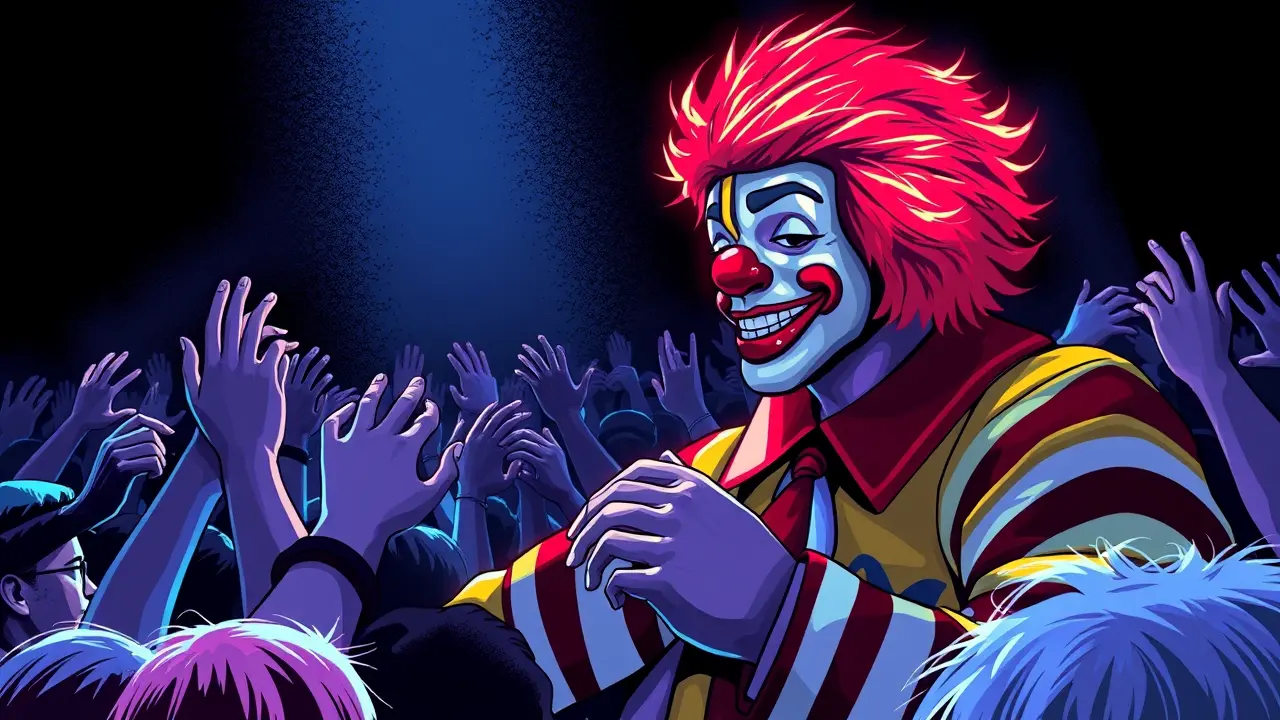Man in Ronald McDonald Costume Arrested for Alleged Groping.
The sacred, communal space of the mosh pit, a place where bodies move in a chaotic symphony of shared release, was violated in the most cynical of ways at the Aftershock music festival earlier this month, proving that even the most seemingly innocent of icons can be corrupted. Imagine the scene: the relentless, percussive thump of the kick drum vibrating through the soles of your boots, the electric wail of a guitar solo cutting through the humid night air, and a sea of uplifted hands passing a crowd surfer toward the stage like a modern-day rite of passage.Into this tableau of unbridled, if aggressive, joy, stepped a figure of jarring incongruity—a man in a full Ronald McDonald costume, his garish red wig and painted-on smile a grotesque parody of cheer. According to reports from Loudwire and subsequent confirmation from the Sacramento Police Department, this individual wasn't there to spread clownish goodwill; he was arrested on allegations of using his costumed anonymity as a shield to grope women as they were passed overhead, defenseless in their moment of flight.This isn't just another depressing dispatch from the long-standing front of concert safety; it's a dissonant chord struck at the intersection of fandom, trust, and predation. The festival circuit, from Coachella's sun-drenched fields to the muddy trenches of Download, has always operated on a fragile social contract—a shared understanding that while the energy might be frenetic, there is a line that shall not be crossed.This incident, so brazen in its execution, feels like a fundamental breach of that pact. It echoes other infamous moments where costumes have been weaponized, though perhaps none so surreal as this bastardization of a globally recognized, if commercially manufactured, symbol of childhood.One must ponder the calculated premeditation: sourcing the costume, traveling to the venue, sweating under the synthetic fibers amidst thousands, all with the apparent intent to commit a violation. It’s a act that speaks to a profound cowardice, exploiting the very culture of acceptance and letting loose that defines such events.For the women involved, the experience transforms what should be a pinnacle of musical communion—the weightless feeling of being carried by the crowd—into a moment of violation, the memory of the music now forever intertwined with the image of that sinister, grinning mask. The conversation around safety at large-scale concerts has been evolving, thankfully, with many promoters implementing dedicated ‘safe space’ tents, explicit codes of conduct, and better training for security staff to identify and eject perpetrators.Yet, this case presents a unique challenge: how do you spot a predator when he’s dressed as a fast-food mascot? It underscores the insidious nature of such offenses and the constant need for vigilance, not just from security, but from the community itself—the fellow concertgoers who must be empowered and willing to call out aberrant behavior, to become the guardians of the pit. The fallout extends beyond the festival grounds, casting a long shadow over the very idea of cosplay and fan expression, which are integral parts of the metal and rock scene.From the elaborate armor of battle jackets to the full-face makeup of corpse paint, adopting a persona is a form of tribute and escape. This arrest risks casting a suspicious eye on all costumed attendees, forcing a community built on non-conformity to confront the uncomfortable reality that a mask can hide malice as easily as it expresses fandom. The rhythmic pulse of the music, which should be a unifying force, was, for a moment, drowned out by a much uglier beat—a reminder that the battle for the soul of live music is never truly won, and that the work to protect its sacred spaces is a continuous, necessary encore.
Latest News
The charts are whispering what the true believers have felt in their bones for weeks—Dogecoin is carving out a bottom.
17 hours ago5 comments
The Institute for Fiscal Studies has thrown a stark warning onto Rachel Reeves's desk, urging the Chancellor to confront a potential £22 billion shortfall in
17 hours ago3 comments
Alright, let's break down this absolute heater of a performance from the Chicago Blackhawks, because if you missed this one, you missed a party.
18 hours ago5 comments
The ice was hot last night in the NHL, folks, serving up a slate of games that felt less like a regular season Tuesday and more like a playoff preview with a
18 hours ago3 comments
The XRP chart is painting a tantalizing picture for those with the stomach to withstand the relentless pressure from crypto's leviathans.
18 hours ago4 comments
It’s in the small shifts, the quiet recalibrations of a Thursday morning, where the most meaningful change often takes root.
18 hours ago4 comments
In a move that sent ripples of quiet confidence through the crypto ecosystem, blockchain intelligence firms tracked a monumental treasury allocation from
18 hours ago4 comments
In a move that would have drawn a nod of approval from historical figures like Churchill, who understood the delicate balance of power within democratic
18 hours ago2 comments
JA
Jamie Larson123k14 hours ago
ugh reading this just makes my stomach turn, that feeling of being carried by the crowd is supposed to be pure freedom and he just ruined it smh
0
JA
Jamie Larson123k14 hours ago
wait what a ronald mcdonald suit smh that's a new low for humanity tbh
0
JA
Jamie Larson123k16 hours ago
wait what a ronald mcdonald suit tho that's just so weird and messed up smh
0
JA
Jamie Wilson123k19 hours ago
wait what data is that 85% figure even from tbh i feel like that number is just thrown around without any real source
0
JA
Jamie Larson123k20 hours ago
a ronald mcdonald costume tho?? what is even happening smh
0
JA
Jamie Larson123k20 hours ago
of course it was a ronald mcdonald costume smh what a cowardly way to try and get away with that
0
